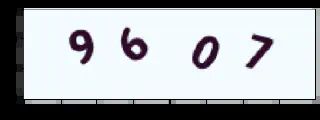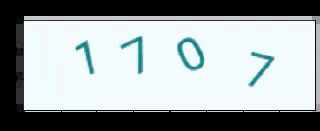使用PyTorch识别简单验证码
前言
在这篇文章中,我们将演示如何使用PyTorch来识别简单的数字图形CAPTCHA。示例比较简单,主要演示图片预处理及简单的CNN网络。
环境准备
安装依赖包
conda install pytorch torchvision torchaudio cpuonly -c pytorch
sudo apt-get install libgl1 # for opencv
pip install requests matplotlib opencv-python
下载验证码图片(我们将验证码的值放在HTTP头中返回,方便的对原始数据集进行标注,更一般的情况需要对图片进行人工标注):
CAPTCHA_URL = 'https://captcha.tomo.wang'
r = requests.get(CAPTCHA_URL)
captcha = r.headers['X-Captcha']
with open('{}.png'.format(captcha), 'wb') as f:
f.write(r.content)
图像处理及训练
准备
首先我们导入需要用到的包
import os
import re
import sys
import argparse
import glob
from io import BytesIO
import requests
import numpy as np
import cv2
import matplotlib.pyplot as plt
import torch
from torch.autograd import Variable
import torch.nn.functional as F
定义程序运行的相关常量
- 字符个数
- 验证码宽高
- 裁剪后字符的宽高
- …
NUM_CHARS = 4
CAPTCHA_WIDTH = 200
CAPTCHA_HEIGHT = 62
CH_WIDTH = 20
CH_HEIGHT = 28
CAPTCHA_DIR = './images'
TORCH_NET_PATH = 'captcha.torch'
BG_COLOR = (243, 251, 254) # captcha backgroud color
BG_THRESHOLD = 245
BLANK_THRESHHOLD = 1
DOTS_THRESHOLD = 3
CH_MIN_WIDTH = 8
获取验证码图片并展示
def get_captcha():
CAPTCHA_URL = 'https://captcha.tomo.wang'
r = requests.get(CAPTCHA_URL)
return r.content
img = get_captcha()
plt.imshow(plt.imread(BytesIO(img)))
一个验证码图片包含背景和不同颜色的字符,共四个字符,在训练前需要对其进行灰化处理,并进行切割
img_array = np.asarray(bytearray(img), dtype=np.uint8)
img = cv2.imdecode(img_array, cv2.IMREAD_GRAYSCALE)
assert img.shape == (CAPTCHA_HEIGHT, CAPTCHA_WIDTH)
img = cv2.threshold(img, BG_THRESHOLD, 255, cv2.THRESH_BINARY_INV)[1]
plt.imshow(cv2.cvtColor(img, cv2.COLOR_GRAY2BGR))
切割
将图片切割成四个独立的字符
def _denoise(img):
img = cv2.threshold(img, BG_THRESHOLD, 255, cv2.THRESH_BINARY_INV)[1]
return img
def _preprocess(img):
img = img.copy()
img = _denoise(img)
return img
def find_filled_row(rows):
for i, row in enumerate(rows):
dots = np.sum(row) // 255
if dots >= DOTS_THRESHOLD:
return i
assert False, 'cannot find filled row'
def pad_ch(ch):
pad_w = CH_WIDTH - ch.shape[1]
assert pad_w >= 0, 'bad char width'
pad_w1 = pad_w // 2
pad_w2 = pad_w - pad_w1
pad_h = CH_HEIGHT - ch.shape[0]
assert pad_h >= 0, 'bad char height'
pad_h1 = pad_h // 2
pad_h2 = pad_h - pad_h1
return np.pad(ch, ((pad_h1, pad_h2), (pad_w1, pad_w2)), 'constant')
def segment(img):
# Search blank intervals.
img = _preprocess(img)
dots_per_col = np.apply_along_axis(lambda row: np.sum(row) // 255, 0, img)
blanks = []
was_blank = False
first_ch_x = None
prev_x = 0
x = 0
while x < CAPTCHA_WIDTH:
if dots_per_col[x] >= DOTS_THRESHOLD:
if first_ch_x is None:
first_ch_x = x
if was_blank:
# Skip first blank.
if prev_x:
blanks.append((prev_x, x))
# Don't allow too tight chars.
x += CH_MIN_WIDTH
was_blank = False
elif not was_blank:
was_blank = True
prev_x = x
x += 1
blanks = [b for b in blanks if b[1] - b[0] >= BLANK_THRESHHOLD]
# Add last (imaginary) blank to simplify following loop.
blanks.append((prev_x if was_blank else CAPTCHA_WIDTH, 0))
# Get chars.
chars = []
x1 = first_ch_x
widest = 0, 0
for i, (x2, next_x1) in enumerate(blanks):
width = x2 - x1
# Don't allow more than CH_WIDTH * 2.
extra_w = width - CH_WIDTH * 2
extra_w1 = extra_w // 2
extra_w2 = extra_w - extra_w1
x1 = max(x1, x1 + extra_w1)
x2 = min(x2, x2 - extra_w2)
ch = img[:CAPTCHA_HEIGHT, x1:x2]
y1 = find_filled_row(ch[::])
y2 = CAPTCHA_HEIGHT - find_filled_row(ch[::-1])
ch = ch[y1:y2]
chars.append(ch)
if width > widest[0]:
widest = x2 - x1, i
x1 = next_x1
# Fit chars into boxes.
chars2 = []
for i, ch in enumerate(chars):
widest_w, widest_i = widest
# Split glued chars.
if len(chars) < NUM_CHARS and i == widest_i:
ch1 = ch[:, 0:widest_w // 2]
ch2 = ch[:, widest_w // 2:widest_w]
chars2.append(pad_ch(ch1))
chars2.append(pad_ch(ch2))
else:
ch = ch[:, 0:CH_WIDTH]
chars2.append(pad_ch(ch))
assert len(chars2) == NUM_CHARS, 'bad number of chars'
return chars2
chars2 = segment(cv2.imdecode(img_array, cv2.IMREAD_GRAYSCALE))
fig = plt.figure()
for i, char in enumerate(chars2):
a = fig.add_subplot(1, 4, i+1)
plt.imshow(cv2.cvtColor(char, cv2.COLOR_GRAY2BGR))
其他图片相关处理函数
def check_image(img):
assert img is not None, 'cannot read image'
assert img.shape == (CAPTCHA_HEIGHT, CAPTCHA_WIDTH), 'bad image dimensions'
def read_image_file(fpath):
with open(fpath, 'rb') as f:
return decode_image(f.read())
def decode_image(data):
data = np.frombuffer(data, np.uint8)
img = cv2.imdecode(data, cv2.IMREAD_GRAYSCALE)
check_image(img)
return img
def get_ch_data(img):
data = img.flatten() & 1
assert len(data) == NUM_INPUT, 'bad data size'
return data
神经网络以及训练
# nn net define
NUM_INPUT = CH_WIDTH * CH_HEIGHT
NUM_NEURONS_HIDDEN = NUM_INPUT // 3
NUM_OUTPUT = 10
class Net(torch.nn.Module):
def __init__(self, n_feature, n_hidden, n_output):
super(Net, self).__init__()
self.hidden = torch.nn.Linear(n_feature, n_hidden) # hidden layer
self.out = torch.nn.Linear(n_hidden, n_output) # output layer
def forward(self, x):
x = F.relu(self.hidden(x)) # activation function for hidden layer
x = self.out(x)
return x
基于之前获取的字符集开始训练
def train(captchas_dir):
net = Net(n_feature=NUM_INPUT, n_hidden=NUM_NEURONS_HIDDEN, n_output=NUM_OUTPUT)
optimizer = torch.optim.SGD(net.parameters(), lr=0.02, momentum=0.9)
loss_func = torch.nn.CrossEntropyLoss()
captchas_dir = os.path.abspath(captchas_dir)
captchas = glob.glob(captchas_dir + '/*.png')
x, y = [], []
for i, name in enumerate(captchas):
answer = re.match(r'.*(\d{4})\.png$', name)
if not answer:
continue
answer = answer.group(1)
fpath = os.path.join(captchas_dir, name)
try:
img = read_image_file(fpath)
ch_imgs = segment(img)
for ch_img, digit in zip(ch_imgs, answer):
x.append(get_ch_data(ch_img))
y.append(int(digit))
except Exception as e:
print('Error occured while processing {}: {}'.format(name, e))
else:
if (i + 1) % 25 == 0:
print('{}/{}'.format(i + 1, len(captchas)))
x, y = torch.from_numpy(np.array(x)).type(torch.FloatTensor), torch.from_numpy(np.array(y)).type(torch.LongTensor)
x, y = Variable(x), Variable(y)
for t in range(100):
out = net(x) # input x and predict based on x
loss = loss_func(out, y) # must be (1. nn output, 2. target), the target label is NOT one-hotted
optimizer.zero_grad() # clear gradients for next train
loss.backward() # backpropagation, compute gradients
optimizer.step() # apply gradients
return net
net = train(CAPTCHA_DIR)
25/400
50/400
75/400
100/400
125/400
150/400
175/400
200/400
225/400
250/400
275/400
300/400
325/400
350/400
375/400
400/400
print(net)
Net(
(hidden): Linear(in_features=560, out_features=186, bias=True)
(out): Linear(in_features=186, out_features=10, bias=True)
)
预测新图形
def predict(net, img_content):
def get_digit(ch_img):
x = torch.from_numpy(get_ch_data(ch_img)).type(torch.FloatTensor)
output = net(Variable(x))
_, predicted = torch.max(output.data, 0)
# return str(Variable(predicted).data[0])
return str(predicted.item())
img = decode_image(img_content)
ch_imgs = segment(img)
return ''.join(map(get_digit, ch_imgs))
img_content = get_captcha()
plt.imshow(plt.imread(BytesIO(img_content)))
result = predict(net, img_content)
plt.title(result)
Text(0.5, 1.0, '1707')



